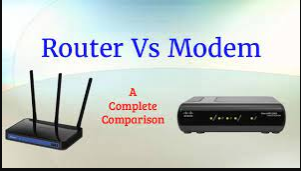 |
| Modem & Router |
the difference between a modem and a router Because a lot of people actually think that a modem and a router are the same thing But they are not. They are different with two separate roles on a network So I'm going to explain the difference between the two Now if you want internet inside your home or business, you have to have a modem. A modem is what brings the internet into your home or business. A modem establishes and maintains a dedicated connection to your internet service provider to give you access to the internet. Now the reason why you have to have a modem is because of the two different types of signals that are used on a computer and on the internet. A computer only reads digital signals, while signals out on the internet are analog. As analog data comes in from the internet, the modem demodulates the incoming analog signals into a digital signal so that a computer can understand it. And a modem also modulates outgoing digital signals from a computer into an analog signal as it goes out on the internet. And this is where we get the word 'modem'. The word modem means modulator demodulator which is exactly what a modem does. It modulates outgoing data from a computer and demodulates incoming data from the internet Now a router comes in after the modem. Now there are different types of routers There are routers that are used in businesses and larger organizations And there are smaller routers that are used in homes and small businesses But they basically do the same thing. But for this video
 |
| Modem & Router |
we're going to use the small office/home office router that most of us are familiar with Now a router is what routes or passes your internet connection to all of your devices in your home or business. It directs it to all of your computers, tablets, phones and so on so that those devices can access the internet A typical small office/home office router, like this one here, will have a built-in switch with multiple ports so that you can connect multiple devices using an ethernet cable connection And it also functions as a wireless access point so that wireless devices such as tablets and laptops can have internet access Now technically you really don't need a router if you only want one of your devices to access the internet. You can just plug that device's network cable directly into the modem, and then you'll be able to access the internet. However, like most homes and businesses you're going to have multiple devices that need access to the internet, and that's where you would need a router. There are also different types of modems. Two of the most common types are cable and DSL modems. So depending upon what type of internet you're going to use, you need to use the correct type of modem. Cable modems are connected to your home using a coaxial cable. Cable is typically provided by the same company that provides you with cable television such as Comcast, which is one of the largest providers in the United States. And DSL modems are connected using a typical phone line. DSL is provided by companies such as AT&T, which is the largest provider in the U.S. Now a lot of times your internet service provider when they send you a modem, or if you were to buy one at the store, the modem might be a modem/router combination. So it will be a modem with a built-in wireless router in one physical device, such as this one here So here is an example of several different networks on how they connect to the internet. For example, this network here on the left is using a cable modem. And it's using a small office/home office router so that its computers and the tablet can have internet access. On a bottom we have another network. And this network is using a DSL modem.
 |
| Modem & Router |
And it's also using a small office/home office router so that its computers, the laptop, and the tablet can access the internet. The network here on the right is an example of a business network. And it's using a cable modem, and it's using a business router so it can connect its computers and its server. And finally we have the network here on top. And this only has one device that needs internet access. So it doesn't need to use a router. It can just directly connect to the modem because only one device needs internet access. Now if you're wondering how hubs and switches relate to routers and modems, well keep in mind that most routers will have a built in switch inside of them. So there's no need to have a switch if you already have a router that has a switch built into it. So for example a router like this may have a four port integrated switch so that you can connect four Ethernet cables for your wired devices. So the only time may need to add a switch to this network is if you needed more wired connections for your devices. So you can just connect a switch to your router and then add more connections to the switch. So just to clear things up even more, over here we have the internet with all of its routers Then as the internet is routed into this private network, it first reaches the modem, then it goes from the modem to its router with its integrated switch and then it's passed to all of its computers.




0 Comments